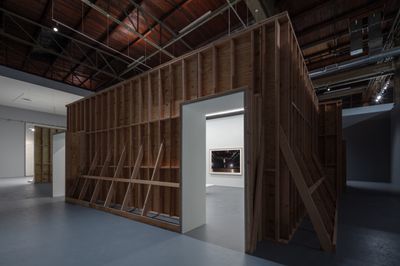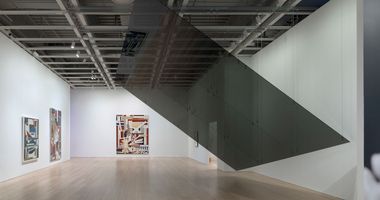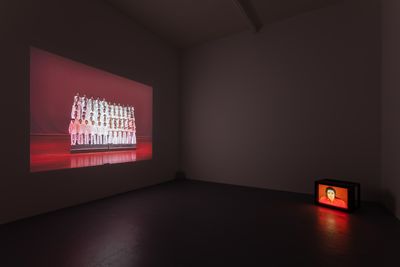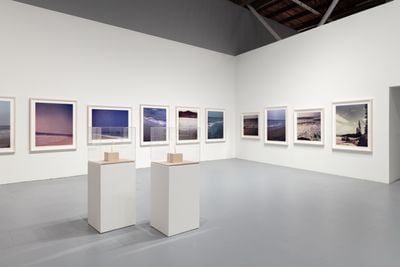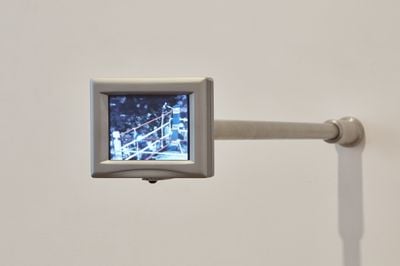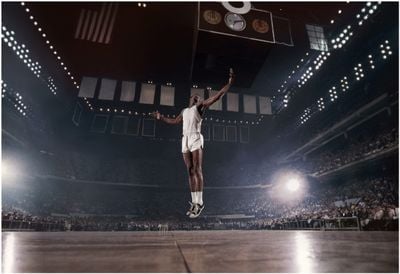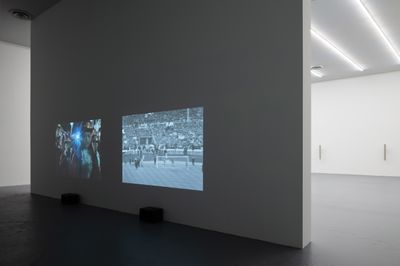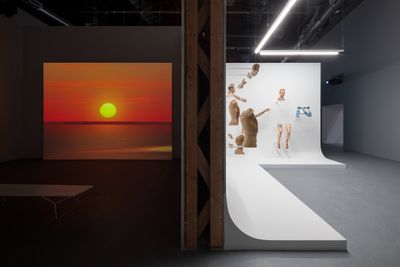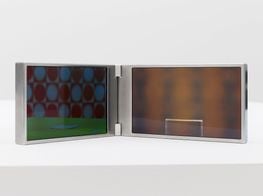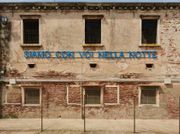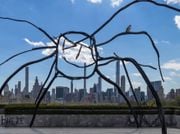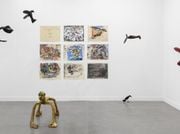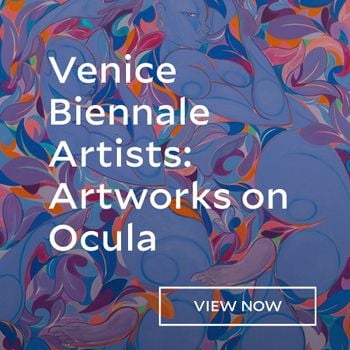Paul Pfeiffer's Spectacle of Scale at MoCA's Geffen
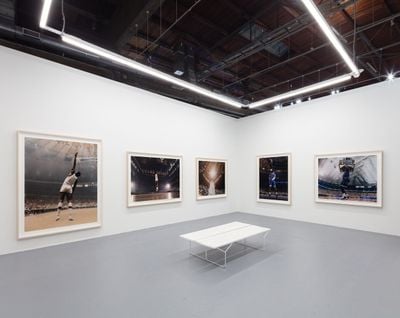
Paul Pfeiffer, 'Four Horsemen of the Apocalypse' series (2004–2018). Exhibition view: Prologue to the Story of the Birth of Freedom, The Geffen Contemporary at MOCA, Los Angeles (12 November 2023–16 June 2024). Courtesy The Museum of Contemporary Art (MOCA). Photo: Zak Kelley.
In a video accompanying Paul Pfeiffer's Los Angeles retrospective, the artist states, 'I think of art as the finger that points.'1
Presented in the Geffen building of MoCA, Prologue to the Story of the Birth of Freedom features monumental installations, roaring soundscapes, large-format photography, and tiny flickering films. Organised by Clara Kim and Paula Kroll in close collaboration with the artist, the show unfolds across a labyrinth of rooms. Though it spans the last 25 years, each work feels absolutely current, drawing attention to the mass media forces that influence how we behave and think.
The opening room combines three of the artist's earliest works, John 3:16 (2000), The Pure Products Go Crazy (1998), and Fragment of a Crucifixion (After Francis Bacon) (1999). Each displays a palm-sized grainy moving image on consumer-grade equipment from the late 1990s, long before the ubiquity of hand held devices and the seductive scroll of social media. Pfeiffer gleaned the imagery from Hollywood drama and televised basketball footage, isolating and repeating single instants in a kind of proto-gif. The result is mesmerising.
At the centre is John 3:16, an LCD monitor showing a spinning basketball pushed by multiple hands. Pfeiffer stitched together over 5,000 video stills to achieve the effect, but the editing appears purposefully imperfect. The film has discontinuities that point to the artist's mediation. The other two works are equally glitchy, though each focuses on just one moment of appropriated footage, played on a loop and projected on the wall.
The Pure Products Go Crazy features less than a second of Risky Business, the 1983 film that catapulted Tom Cruise to superstardom. Cruise is shown trapped in an infantile, tantrum-like action, lying face down in underwear with his arms and legs flailing. Fragment of a Crucifixion turns the focus on Larry Johnson, the basketballer who in 1993 signed what was then the most lucrative contract in basketball history—worth U.S. $84 million. The original source footage captures the basketballer celebrating a winning shot, but Pfeiffer has stripped the image of sound and extraneous details, instead zeroing in on Johnson with his fists clenched and his mouth open in a silent scream.
The artist made these last two works shortly after participating in the Whitney Museum of American Art's Independent Study Program. They also featured in the 2000 Whitney Biennial, where Fragment of a Crucifixion earned Pfeiffer the inaugural Bucksbaum Award for demonstrating 'the potential to make a lasting impact on the history of American art'. The Geffen show is a testament to the jury's selection.
While the Whitney programme played a crucial role in shaping Pfeiffer's artistic practice, leading him to focus more on the technology of representation, his personal history appears also to have had a profound influence. Born in the U.S., in Honolulu in 1966, Pfeiffer is of Filipino heritage and spent his teenage years in the Philippines, where his musical parents moved to take up academic positions. Following his return to the U.S., he earned an MFA from New York's Hunter College in 1994, where he focused on photo-based installations exploring ideas around identity. He credits the late artist Carlos Villa, who was his mentor and of Filipino heritage also, in helping him to understand how his biography could relate to his art.2
Throughout the Geffen show questions arise around the role of the image in the construction of identity: a phenomenon mined by corporations, the media, and celebrity culture. The second room presents 24 Landscapes (2000–2008), a series of large-format Cibachrome images showing the horizon line of a beach meeting the sky, the backdrop to a photoshoot by George Barris of Marilyn Monroe on Santa Monica Beach in July 1962, only weeks before the 36-year-old actress was found dead. Here, Pfeiffer has digitally removed all traces of Monroe, leaving only a picturesque ocean landscape.
As Susan Sontag said in her seminal essay 'On Photography' (1977), 'To photograph is to appropriate the thing photographed', and the images in this room, even when vacated of the screen siren, carry the weight of her tragic fame. Through erasure, repetition, and other editing tactics, the audience is reminded that an image is never a copy of reality but something distinct from that it attempts to reproduce. In light of artificial intelligence's capacity to generate a person's likeness in their absence, these images feel even more prescient.
Tactics of defamiliarisation lead to a sense of the uncanny throughout the show. In the 'Live Evil' series (2002-2018), a dancing Michael Jackson appears as an alien mantis-like creature, dehumanised through the editing process. Plays on scale are also used: the largess of celebrity is contained within miniature projections, and intimate moments are created from broadcast images meant for millions. Pfeiffer has explained that he is asking the viewer to regard the video image with the contemplation normally reserved for painting.3
Pfeiffer often directly references the structures that underpin mass media. He almost always incorporates the technology that births an image into his work. Self-Portrait as a Fountain (2000) takes this a step further. It includes a recreation of the studio set from the shower scene of Alfred Hitchcock's classic Psycho (1960) in which Janet Leigh's character is stabbed to death. While Leigh does not appear in the installation, one can imagine her enacting that scene, surrounded by crew and vulnerable under the studio lights. Her absence echoes that of Monroe, while her 'silent' scream resonates with that of Johnson's in John 3:16.
Vitruvian Figure (2008) consists of another replica, this time a room-size miniature of a stadium built for the 2000 Sydney Olympics. In his reconstruction, the artist again plays with scale, exaggerating the stadium's seating capacity, increasing it from 110,000 to a staggering million seats. It recalls the Roman gladiator arena. Despite being empty, it conjures up the horror of mass dissemination, where an image of a person can be shared with a braying crowd of millions in an instant, and infinitely.
In an interview for The New York Times, the artist explains his desire to scramble the assumption that visibility equates to agency.4 Indeed he often focuses on images where the light interrupts the shot, 'hiding' the main subject. The nine large-format C-prints that make up Four Horsemen of the Apocalypse (2000–ongoing) each feature a basketballer caught in graceful movement. However, the men are rendered anonymous, their faces turned from the camera or blurred in the glare of stadium lighting.
While many of the works focus on individuals, Pfeiffer is less interested in the specific person than in the mass hysteria triggered by the spectacle of worship surrounding them. Similarly, he is intrigued by how large-scale events orchestrate experiences to mould and shape personal and collective identity.
Projected cinema style in a dark room, Red Green Blue (2022) was created during Pfeiffer's tenure at the University of Georgia and focuses on the institution's sports stadium, which he reimagined as a massive broadcasting studio. In crystal-clear high definition, the film features imagery from an American football game, focusing on the peripheral space of the audience and the stadium architecture. Pfeiffer zooms in on the Redcoats' band director, who conducts music ranging from Kanye West's 'Power' (2010) to the theme for Superman. The director not only wields influence over the band, but in effect, he controls the stadium's audience, such that the roar of the crowd fluctuates with the tempo of the music.
A tiny video, Sunset Flash (2004), reflects the conductor's movements. It shows Pfeiffer's extended family posing for a group portrait. Awkwardly composed, the artist's relations are relegated to the lower edge of the frame, drawing attention to the photographer's hands directing everyone into place.
At the Geffen, it is Pfeiffer and his collaborators who are the puppet masters. With the assistance of architectural firm Büro Koray Duma, the show has been designed to resemble a Hollywood studio stage. It is an immersive exhibition, and the audience is invited to consume works in a preferred order, with the pace controlled through fluctuating temporal durations. I felt myself sucked into viewing repeated fragments of seconds but then drawn to sit and contemplate footage that only reveals itself slowly. One must close in on small videos, stand back from those enlarged, bend down to view those placed low on the floor and gaze upwards at monitors set on high. There are ramps to climb, stadium seats to sit on, peepholes to look through, and large format images stationed around a room, prompting the body to spin. In this way, Pfeiffer activates the negative space around the objects in his show, choreographing the audience not unlike the band director in Red Green Blue or the photographer in Sunset Flash. Yet the option to opt-out or take a different path is always there.
Maybe Prologue to the Story of the Birth of Freedom ultimately affords us an opportunity to consider who we might be if not for the cultural forces that surround us, and to plot how we might live despite them.
Prologue to the Story of the Birth of Freedom is on view at The Geffen at Museum of Contemporary Art in Los Angeles from 12 November 2023 until 16 June 2024.
1 'Paul Pfeiffer: Interrupting the Broadcast', Art21 'Extended Play', Video, 2023.
2 Chloe Veltman, 'How one Filipino American artist influenced the work of a generation of others', NPR, 30 September 2022.
3 Digital wall label from the Whitney Museum of American Art's collection, Paul Pfeiffer, The Pure Products Go Crazy (1998), web: https://whitney.org/collection/works/12225.
4 Travis Diehl, 'Frame by Frame, an Artist Distills What Sports Cameras Blur', The New York Times, 2024.

